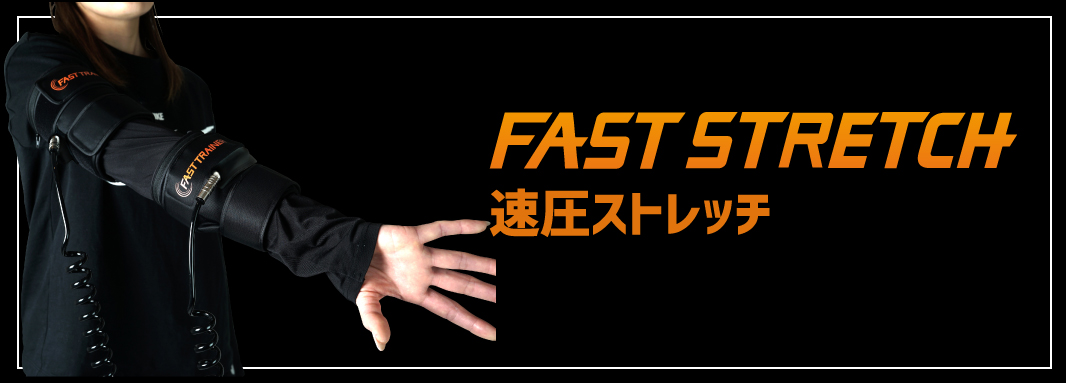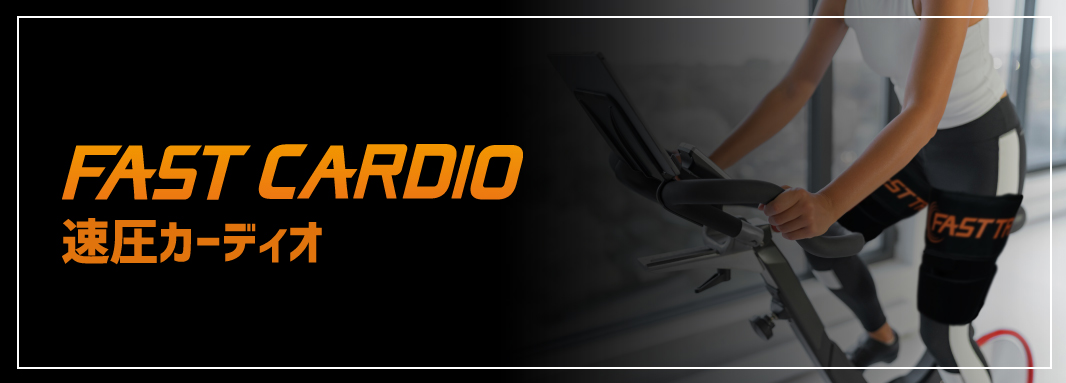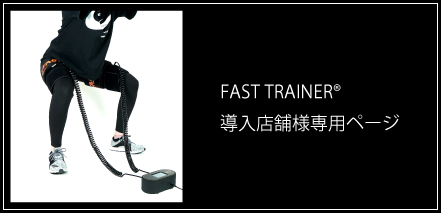FAST CARDIO/速圧カーディオ
有酸素運動をしながら速筋のトレーニング
有酸素運動(Cardio Exercise)と筋トレを同時に漕ぐだけ、歩くだけで高強度インターバルトレーニングと同様の結果をもたらすことができます。難しい動きも知識も必要なくシェイプアップ、健康維持目的などに非常に効果的なメソッドです。

― 漕ぐだけ、歩くだけ
VO2MAXの30%強度の程度で、圧迫と除圧を自動で繰り返しながら10~20分エクササイズバイクやウォーキングマシンなどを使用した筋力アップと持久力アップを同時に行うことができます。30秒~60秒圧迫した状態で運動、30秒~120秒除圧状態で運動×10セットなど、体調や普段の運動量などに合わせて設定をします。
低強度
VO2maxの30~40%程度の低強度の運動でも実感できるほどの結果を引き出すことができます。
筋肉増強と有酸素能力
低酸素状態による速筋活動と低強度で漕ぐ、歩くを続けて行うだけでも、筋肥大と有酸素の力の向上が期待できます。
血行促進
圧迫と解放を繰り返すことによる血流変化で循環の改善も見込め、疲労回復や怪我の早期回復も期待できます。
参考文献
References
只今自社にて運動のデータ取りを行っていますが、他の血流制限方法での過去の参考文献を紹介いたします。
- Abe T., Fujita S., Nakajima T., Sakamaki M., Ozaki H., Ogasawara R., et al. . (2010). Effects of low-intensity cycle training with restricted leg blood flow on thigh muscle volume and VO2MAX in young men. J. Sports Sci. Med. 9, 452–458. [PMC free article] [PubMed] [Google Scholar]
- Abe T., Kearns C. F., Sato Y. (2006). Muscle size and strength are increased following walk training with restricted venous blood flow from the leg muscle, Kaatsu-walk training. J. Appl. Physiol. 100, 1460–1466. 10.1152/japplphysiol.01267.2005 [PubMed] [CrossRef] [Google Scholar]
- Beard A., Ashby J., Chambers R., Brocherie F., Millet G. P. (2018). Repeated-sprint training in hypoxia in international rugby union players. Int. J. Sports Physiol. Perform. 14, 850–854. 10.1123/ijspp.2018-0170 [PubMed] [CrossRef] [Google Scholar]
- Beard A., Ashby J., Kilgallon M., Brocherie F., Millet G. P. (2019). Upper-body repeated-sprint training in hypoxia in international rugby union players. Eur. J. Sport Sci. 19, 1175-1183. 10.1080/17461391.2019.1587521 [PubMed] [CrossRef] [Google Scholar]
- Bodkin D., Escalera P., Bocam K. (2006). A human lunar surface base and infrastructure solution, in AS-10: Space Architecture Symposium: Lunar and Planetary Surface Systems and Construction I (San Jose, CA: AIAA; ), 1–17. 10.2514/6.2006-7336 [CrossRef] [Google Scholar]
- Brechbuhl C., Brocherie F., Millet G. P., Schmitt L. (2018). Effects of repeated-sprint training in hypoxia on tennis-specific performance in well-trained players. Sports Med. Int. Open 2, E123–E132. 10.1055/a-0719-4797 [PMC free article] [PubMed] [CrossRef] [Google Scholar]
- Brocherie F., Girard O., Faiss R., Millet G. P. (2017). Effects of repeated-sprint training in hypoxia on sea-level performance: a meta-analysis. Sports Med. 47, 1651–1660. 10.1007/s40279-017-0685-3 [PubMed] [CrossRef] [Google Scholar]
- Brocherie F., Millet G. P., D’Hulst G., Van Thienen R., Deldicque L., Girard O. (2018). Repeated maximal-intensity hypoxic exercise superimposed to hypoxic residence boosts skeletal muscle transcriptional responses in elite team-sport athletes. Acta Physiol. 222:e12851. 10.1111/apha.12851 [PubMed] [CrossRef] [Google Scholar]
- Casey D. P., Joyner M. J. (2012). Compensatory vasodilatation during hypoxic exercise: mechanisms responsible for matching oxygen supply to demand. J. Physiol. 590, 6321–6326. 10.1113/jphysiol.2012.242396 [PMC free article] [PubMed] [CrossRef] [Google Scholar]
- Conceicao M. S., Junior E. M. M., Telles G. D., Libardi C. A., Castro A., Andrade A. L. L., et al. . (2019). Augmented anabolic responses after 8-wk cycling with blood flow restriction. Med. Sci. Sports Exerc. 51, 84–93. 10.1249/MSS.0000000000001755 [PubMed] [CrossRef] [Google Scholar]
- Demontis G. C., Germani M. M., Caiani E. G., Barravecchia I., Passino C., Angeloni D. (2017). Human pathophysiological adaptations to the space environment. Front. Physiol. 8:547. 10.3389/fphys.2017.00547 [PMC free article] [PubMed] [CrossRef] [Google Scholar]
- Faiss R., Leger B., Vesin J. M., Fournier P. E., Eggel Y., Deriaz O., et al. . (2013). Significant molecular and systemic adaptations after repeated sprint training in hypoxia. PLoS ONE 8:e56522. 10.1371/journal.pone.0056522 [PMC free article] [PubMed] [CrossRef] [Google Scholar]
- Faiss R., Willis S., Born D. P., Sperlich B., Vesin J. M., Holmberg H. C., et al. . (2014). Repeated double-poling sprint training in hypoxia by competitive cross-country skiers. Med. Sci. Sports Exerc. 47, 809–817. 10.1249/MSS.0000000000000464 [PubMed] [CrossRef] [Google Scholar]
- Ferguson R. A., Hunt J. E. A., Lewis M. P., Martin N. R. W., Player D. J., Stangier C., et al. . (2018). The acute angiogenic signalling response to low-load resistance exercise with blood flow restriction. Eur. J. Sport Sci. 18, 397–406. 10.1080/17461391.2017.1422281 [PubMed] [CrossRef] [Google Scholar]
- Fitzpatrick R., Taylor J. L., McCloskey D. I. (1996). Effects of arterial perfusion pressure on force production in working human hand muscles. J. Physiol. 495 (Pt 3), 885–891. 10.1113/jphysiol.1996.sp021640 [PMC free article] [PubMed] [CrossRef] [Google Scholar]
- Granger H. J., Shepherd A. P., Jr. (1973). Intrinsic microvascular control of tissue oxygen delivery. Microvasc Res 5, 49–72. 10.1016/S0026-2862(73)80006-8 [PubMed] [CrossRef] [Google Scholar]
- Green D. J., Spence A., Halliwill J. R., Cable N. T., Thijssen D. H. (2011). Exercise and vascular adaptation in asymptomatic humans. Exp. Physiol. 96, 57–70. 10.1113/expphysiol.2009.048694 [PubMed] [CrossRef] [Google Scholar]
- Hoppeler H., Vogt M. (2001). Muscle tissue adaptations to hypoxia. J. Exp. Biol. 204(Pt 18), 3133–3139. [PubMed] [Google Scholar]
- Iida H., Kurano M., Takano H., Kubota N., Morita T., Meguro K., et al. . (2007). Hemodynamic and neurohumoral responses to the restriction of femoral blood flow by KAATSU in healthy subjects. Eur. J. Appl. Physiol. 100, 275–285. 10.1007/s00421-007-0430-y [PubMed] [CrossRef] [Google Scholar]
- Kaijser L., Sundberg C. J., Eiken O., Nygren A., Esbjornsson M., Sylven C., et al. . (1990). Muscle oxidative capacity and work performance after training under local leg ischemia. J. Appl. Physiol. 69, 785–787. 10.1152/jappl.1990.69.2.785 [PubMed] [CrossRef] [Google Scholar]
- Lathers C. M., Charles J. B. (1993). Use of lower body negative pressure to counter symptoms of orthostatic intolerance in patients, bed rest subjects, and astronauts. J. Clin. Pharmacol. 33, 1071–1085. 10.1002/j.1552-4604.1993.tb01944.x [PubMed] [CrossRef] [Google Scholar]
- Lewis P. (2018). Is hypoxia-induced skeletal muscle dysfunction lost in space or just a matter of a time? J. Physiol. 596, 2959–2960. 10.1113/JP276033 [PMC free article] [PubMed] [CrossRef] [Google Scholar]
- Lundby C., Calbet J. A., Robach P. (2009). The response of human skeletal muscle tissue to hypoxia. Cell Mol. Life Sci. 66, 3615–3623. 10.1007/s00018-009-0146-8 [PubMed] [CrossRef] [Google Scholar]
- McDonough P., Behnke B. J., Padilla D. J., Musch T. I., Poole D. C. (2005). Control of microvascular oxygen pressures in rat muscles comprised of different fibre types. J. Physiol. 563(Pt 3), 903–913. 10.1113/jphysiol.2004.079533 [PMC free article] [PubMed] [CrossRef] [Google Scholar]
- Millet G. P. (in press). Hypobaric hypoxia as part of the equation. N Engl J Med. [Google Scholar]
- Nakajima T., Iida H., Kurano M., Takano H., Morita T., Meguro K., et al. . (2008). Hemodynamic responses to simulated weightlessness of 24-h head-down bed rest and KAATSU blood flow restriction. Eur. J. Appl. Physiol. 104, 727–737. 10.1007/s00421-008-0834-3 [PubMed] [CrossRef] [Google Scholar]
- Park S., Kim J. K., Choi H. M., Kim H. G., Beekley M. D., Nho H. (2010). Increase in maximal oxygen uptake following 2-week walk training with blood flow occlusion in athletes. Eur. J. Appl. Physiol. 109, 591–600. 10.1007/s00421-010-1377-y [PubMed] [CrossRef] [Google Scholar]
- Patterson S. D., Hughes L., Warmington S., Burr J., Scott B. R., Owens J., et al. . (2019). Blood flow restriction exercise position stand: considerations of methodology, application, and safety. Front. Physiol. 10:533. 10.3389/fphys.2019.00533 [PMC free article] [PubMed] [CrossRef] [Google Scholar]
- Petrick H. L., Pignanelli C., Barbeau P. A., Churchward-Venne T. A., Dennis K. M. J. J., van Loon L. J. C., et al. (2019). Blood flow restricted resistance exercise and reductions in oxygen tension attenuate mitochondrial H2O2 emission rates in human skeletal muscle. J. Physiol. 597, 3985–3997. 10.1113/JP277765. [PubMed] [CrossRef] [Google Scholar]
- Peyrard A., Willis S. J., Place N., Millet G. P., Borrani F., Rupp T. (2019). Neuromuscular evaluation of arm-cycling repeated sprints under hypoxia and/or blood flow restriction. Eur. J. Appl. Physiol. 119, 1533–1545. 10.1007/s00421-019-04143-4 [PubMed] [CrossRef] [Google Scholar]
- Scott B. R., Slattery K. M., Sculley D. V., Dascombe B. J. (2014). Hypoxia and resistance exercise: a comparison of localized and systemic methods. Sports Med. 44, 1037–1054. 10.1007/s40279-014-0177-7 [PubMed] [CrossRef] [Google Scholar]
- Scott J. P. R., Weber T., Green D. A. (2019). Introduction to the frontiers research topic: optimization of exercise countermeasures for human space flight – lessons from terrestrial physiology and operational considerations. Front. Physiol. 10:173. 10.3389/fphys.2019.00173 [PMC free article] [PubMed] [CrossRef] [Google Scholar]
- Slivka D. R. (2017). Skeletal muscle response to hypoxia. Acta Physiol. 220, 9–10. 10.1111/apha.12797 [PubMed] [CrossRef] [Google Scholar]
- Slysz J., Stultz J., Burr J. F. (2016). The efficacy of blood flow restricted exercise: a systematic review & meta-analysis. J. Sci. Med. Sport. 19, 669–675. 10.1016/j.jsams.2015.09.005 [PubMed] [CrossRef] [Google Scholar]
- Stevens P. M., Lamb L. E. (1965). Effects of lower body negative pressure on the cardiovascular system. Am. J. Cardiol. 16, 506–515. 10.1016/0002-9149(65)90027-5 [PubMed] [CrossRef] [Google Scholar]
- Taylor C. W., Ingham S. A., Ferguson R. A. (2016). Acute and chronic effect of sprint interval training combined with postexercise blood-flow restriction in trained individuals. Exp. Physiol. 101, 143–154. 10.1113/EP085293 [PubMed] [CrossRef] [Google Scholar]
- Thijssen D. H., Cable N. T., Green D. J. (2012). Impact of exercise training on arterial wall thickness in humans. Clin. Sci. 122, 311–322. 10.1042/CS20110469 [PMC free article] [PubMed] [CrossRef] [Google Scholar]
- Tomaselli C. M., Frey M. A., Kenney R. A., Hoffler G. W. (1987). Hysteresis in response to descending and ascending lower-body negative pressure. J. Appl. Physiol. 63, 719–725. 10.1152/jappl.1987.63.2.719 [PubMed] [CrossRef] [Google Scholar]
- van der Zwaard S., Brocherie F., Kom B. L. G., Millet G. P., Deldicque L., van der Laarse W. J., et al. . (2018). Adaptations in muscle oxidative capacity, fiber size, and oxygen supply capacity after repeated-sprint training in hypoxia combined with chronic hypoxic exposure. J. Appl. Physiol. 124, 1403–1412. 10.1152/japplphysiol.00946.2017 [PubMed] [CrossRef] [Google Scholar]
- Willis S. J., Alvarez L., Borrani F., Millet G. P. (2018). Oxygenation time course and neuromuscular fatigue during repeated cycling sprints with bilateral blood flow restriction. Physiol. Rep. 6:e13872. 10.14814/phy2.13872 [PMC free article] [PubMed] [CrossRef] [Google Scholar]
- Willis S. J., Borrani F., Millet G. P. (2019a). Leg- vs arm-cycling repeated sprints with blood flow restriction and systemic hypoxia. Eur. J. Appl. Physiol. 119, 1819–1828. 10.1007/s00421-019-04171-0 [PubMed] [CrossRef] [Google Scholar]
- Willis S. J., Peyrard A., Rupp T., Borrani F., Millet G. P. (2019b). Vascular and oxygenation responses of local ischemia and systemic hypoxia during arm cycling repeated sprints. J. Sci. Med. Sport. 22, 1151–1156. 10.1016/j.jsams.2019.05.001 [PubMed] [CrossRef] [Google Scholar]
- Zoll J., Ponsot E., Dufour S., Doutreleau S., Ventura-Clapier R., Vogt M., et al. . (2006). Exercise training in normobaric hypoxia in endurance runners. III. Muscular adjustments of selected gene transcripts. J. Appl. Physiol. 100, 1258–1266. 10.1152/japplphysiol.00359.2005 [PubMed] [CrossRef] [Google Scholar]





